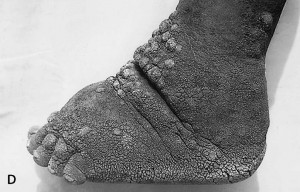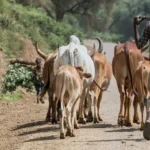Walking home today after having lunch in a nearby cafe, I was asked for money by a middle aged man suffering from podoconiosis, sometimes called Mossy Foot.

I bet you are thinking: podo-what?
Podoconiosis is a disease of people who work barefoot, particularly on red clay soil in the neighborhood of volcanoes, especially at altitude. Tiny micro particles of silica from the volcanic soil penetrate the skin and inflame the lymphatic system. (As a layperson, I think of podoconiosis being to feet what asbestosis is to lungs.)
This disease affects millions of people around the world, including in Ethiopia, Rwanda, Burundi, Cameroon, Tanzania, Equatorial Guinea, Colombia, Ecuador, Brazil, northwest India, and Sri Lanka.
It is a disease of poverty: it can be completely prevented by wearing shoes, and by providing basic information to the people who are at risk from it.
We could eradicate this disease altogether. It would not be very expensive, and it doesn’t require new medical technologies. So why don’t we? The problem seems to be that the people who suffer from this disease are poor and marginalised. There are powerful AIDS lobbies in industrialised countries ensuring that we spend billions of dollars on antiretroviral therapy for people with HIV. But almost nobody is working to highlight the plight of people suffering from podoconiosis and ensuring that we put in the modest resources needed to bring it to an end.
A British academic, Gail Davey, now working in Brighton but formerly living here in Ethiopia, is an exception to this. She is working to get the disease recognised, as step towards getting the disease tackled and eventually eradicated. You can read more about podoconiosis, and the work that Gail does, in a recent article on Humanosphere. Humanosphere is an interesting new blog by Tom Paulson, a journalist based in Seattle, about global health and poverty, and it is well worth including in your regular reading.






8 responses to “Why don’t we tackle diseases of the poor?”
I’m going to start collecting used shoes to send to podoconiosis sufferers right away!
*ducks*
Owen
You are right to point out that while this is a widespread disease, and that the technology exists to prevent it, it isn’t getting sufficient attention because it is a disease of the poor.
BUT
1. It’s not a fatal disease unlike HIV/AIDS, TB, malaria etc. so perhaps tis is also part of the explanation for it getting less attention.
2. While we have a simple technology to fix the problem (Shoes), finding the best way to effectively and sustainably deliver this technology is much more complex than it would at first appear.
The issue is not that there aren’t any shoes in Africa, but that some people can’t afford to buy them, or they don’t consider having shoes sufficiently important to choose to spend any of their limited income to buy them.
This is important because otherwise the most likely reaction would be to buy or collect new (or even used) shoes to be distributed (dumped) in Africa. (to which Cynan jokingly refers). The blog you link to features a video from TOM’s shoes who do exactly that.
It’s good that people are working to find ways to deal with forgotten diseases, especially those that afflict the poor and most marginalized – but I hope that the strategies they use to address these are ones which have a chance of actually working in the long term.
Owen replies: Ian, thanks. I agree with you that this solution is not merely a matter of shipping in shoes. In fact, here in Ethiopia there is now a new, local organisation that is working in the areas where this disease is a problem and addressing the distribution issues (including distributing the Toms shoes), and from what I hear it works pretty well. You can achieve a lot by explaining the causes of the disease, and educating people to wear shoes (and to wash carefully if the symptoms start to develop).
Don’t be so sure that this disease is not fatal – in severe cases, it is probable that it shortens life. And even if it is only the most extreme cases that lead to early death, it has huge effects on the quality of life, and on lifetime earnings.
Following picture taken in Karro (Dembidollo area) in western Ethiopia.
Besides Elephantiasis you’ll find a lot of Goiter there too.
Both diseases are easy to prevent and indeed; why (with relatively low amounts of money) not pick the low hanging fruit …… (as somebody at Gates apparently said).
Well because big people as it turns out hardly ever want to bend down for the low hanging fruit.
Picture Elephantiasis > http://alturl.com/92dy9 The legs are from nice young women being 26 (2008). This leg will not change. More of these legs can – as Owen states – easily be prevented with little money.
Small Dutch NGO is active in this matter in the far West of Ethiopia > http://www.wollega-ethiopie.nl
On Goiter > http://www.strumeth.nl
Picture > http://alturl.com/gjhbx
And the only thing needed is Iodized Salt. But why it is still not easily available ….??
p.s. I work for Dutch grant giving family funds and it is not easy to find fellow grant giving funds for this type of work to be funded. Quite some people follow the band wagon of the big diseases.
Nothing wrong there, but take some money of the big budgets and it can eradicate this type of diseases..
Hope your call will be followed and Gail’s work will be rewarded.
On shoes. Ian is right….
The guy in the following picture > http://alturl.com/wr2uw
is a shoemaker in Nekemte (western Ethiopia).
He makes shoes for people with and without elephantiasis.
Why collect and send shoes while he has difficulties in getting his shop going.
He walks (backward on hands and feet) every morning to his workshop and back in the afternoon.
Get him and his poorest clients some money instead of dumping shoes in ‘his market’ …..
Sounds like a case of the “last mile problem” http://www.ted.com/talks/sendhil_mullainathan.html
Lee,
You might enjoy this ….:
http://stuffwhitepeoplelike.com/2010/09/08/134-the-ted-conference/
Thanks Owen for the post.
Quick further response to Ian – TOMS employ factory workers in Addis to make shoes appropriate for podo and distribute them along with education – far from a ‘dump’.
And one of the points of DALYs is to highlight the importance of diseases that may not be ‘fatal’, but contribute to early death (in this case via hot red leg and then septicaemia) and disability. Podoconiosis may get more attention once it is included in Global Burden of Disease figures… but this can’t happen till it’s acknowledged as a disease by the WHO.